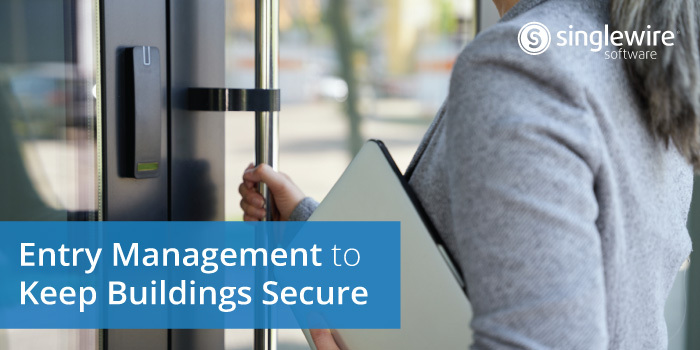Navigating the Complexities Secure Entry Management
For organizations looking to enhance safety and protect their people, the best place to start is at the front door. With a secure entrance, organizations can prevent potential threats from accessing sensitive areas, reducing risk and creating a more secure environment. That means knowing who is coming through your doors and understanding whether or not they have permission to be there. Many organizations are looking for solutions to help address this problem as many have no tool in place or are relying on simple pen and paper sign-in sheets to keep track of guests. Visitor management systems offer a potential solution, but not all options are created equal, and the way they are deployed can impact their effectiveness, which in turn can impact a building’s security. In this post, we will explore best practices for secure entry management, with a particular focus on how best to implement a visitor management system.
Establish a Process for Screening Every Visitor
A visitor screening process can serve as the first line of defense for your building and be a cornerstone of an organization’s entry management process. With a systematic approach, each guest that comes through your door goes through a consistent and standardized process that establishes necessary processes to identify potential threats. A visitor management system requires guests to have their picture taken and present a photo ID to verify their identity. This process should be communicated with staff so they can inform visitors ahead of time and be plainly visible with signage at front entrances so guests understand what is expected of them. This can help avoid uncomfortable situations and can serve as a deterrent for malicious parties who know there are measures in place to prevent them from getting beyond the front door.
Screen Visitors Against National Databases
To help verify visitor identities, systems can use facial recognition technology in conjunction with the personal information provided, to screen individuals against national databases and watchlists. This additional layer of security helps identify potential threats by cross-referencing visitor information with known databases of individuals with malicious intent. Having visitor management software automatically validate visitors with their IDs removes human error from the equation and ensures a swift and accurate identification process. Integrating this capability into the screening process ensures a more comprehensive approach to identifying and mitigating security risks before they enter a building.
Maintain a List of Banned Visitors
Organizations should also consider maintaining a custom list of banned visitors within their visitor management system. Just because someone doesn’t get flagged by appearing on a database, doesn’t mean they don’t pose a threat. Disgruntled ex-employees, upset partners, or other individuals with ill intent can all disrupt operations or cause employees harm. The list should be reviewed and updated regularly based on security incidents, potential threats, or other relevant information. This proactive measure ensures that known offenders are flagged during check-in, preventing them from gaining access to facilities. Having a centralized record of individuals prohibited from entering the premises empowers security personnel to take swift action when necessary, preventing unauthorized access and enhancing overall building security.
Print Badges for Permitted Guests
Implementing a badge system for permitted guests is a tangible and visual way to enhance entry management. Once visitors pass the screening process, issue them badges displaying their name, photo, and other relevant information, such as areas they are permitted to visit. These badges serve as both a form of identification and a visual signal to other occupants that the individual has undergone the necessary security checks. This practice contributes to the overall security culture and facilitates easy identification of authorized personnel within the building.
Look for Flexible Entry Management Hardware Options
Every building is different, so one-size-fits-all hardware options for entry management are less than ideal. Depending on the size of the entrance and how organizations want to manage guests, it may restrict the type of check-in process they want to create. Proprietary hardware can also be costly and if an issue occurs, it can essentially eliminate an organization’s ability to check-in and verify guests. Flexible hardware gives organizations the flexibility to use tools that work best for their environment and budgets, like iPads, handheld scanners, laptops, and badge printers. This enables organizations to maintain secure entry management protocols while also having the freedom to create a welcoming space for visitors.
Connect with Mass Notification for Swift Alerts
Creating a secure entry management process can extend beyond check-in when a visitor management tool is integrated with a mass notification system. In the event of an issue or emergency during check-in, this connection enables swift and widespread alerts to relevant parties who can intervene before an event escalates. Integration has the added benefit of enrolling permitted guests into the notification system during the badging process, so they can receive timely updates and instructions in the event of a crisis. This seamless integration enhances overall communication during critical situations, contributing to a safer building environment.
Secure Buildings with Robust Entry Management
Prioritizing a secure entry management process is a fundamental aspect of maintaining a secure building. By establishing thorough screening processes, utilizing advanced screening against national databases, maintaining lists of banned visitors, issuing badges to permitted guests, integrating with mass notification systems, and leveraging appropriate and flexible technology, organizations can create a comprehensive entry management system. These best practices collectively contribute to a secure workplace, promoting the safety of occupants and protecting your building from potential security threats. For more insights and solutions tailored to your entry management needs, explore our offerings on the visitor management page.
